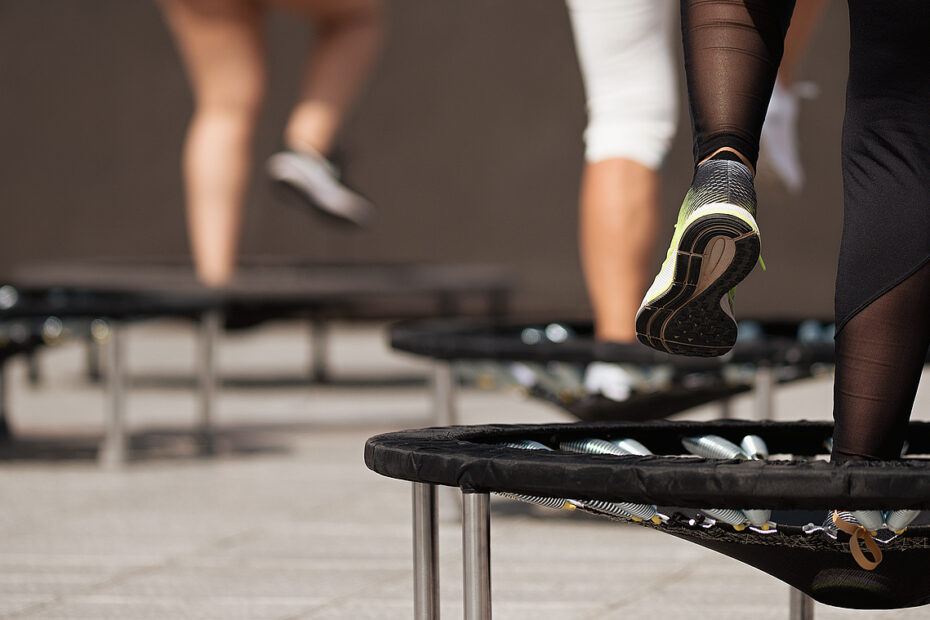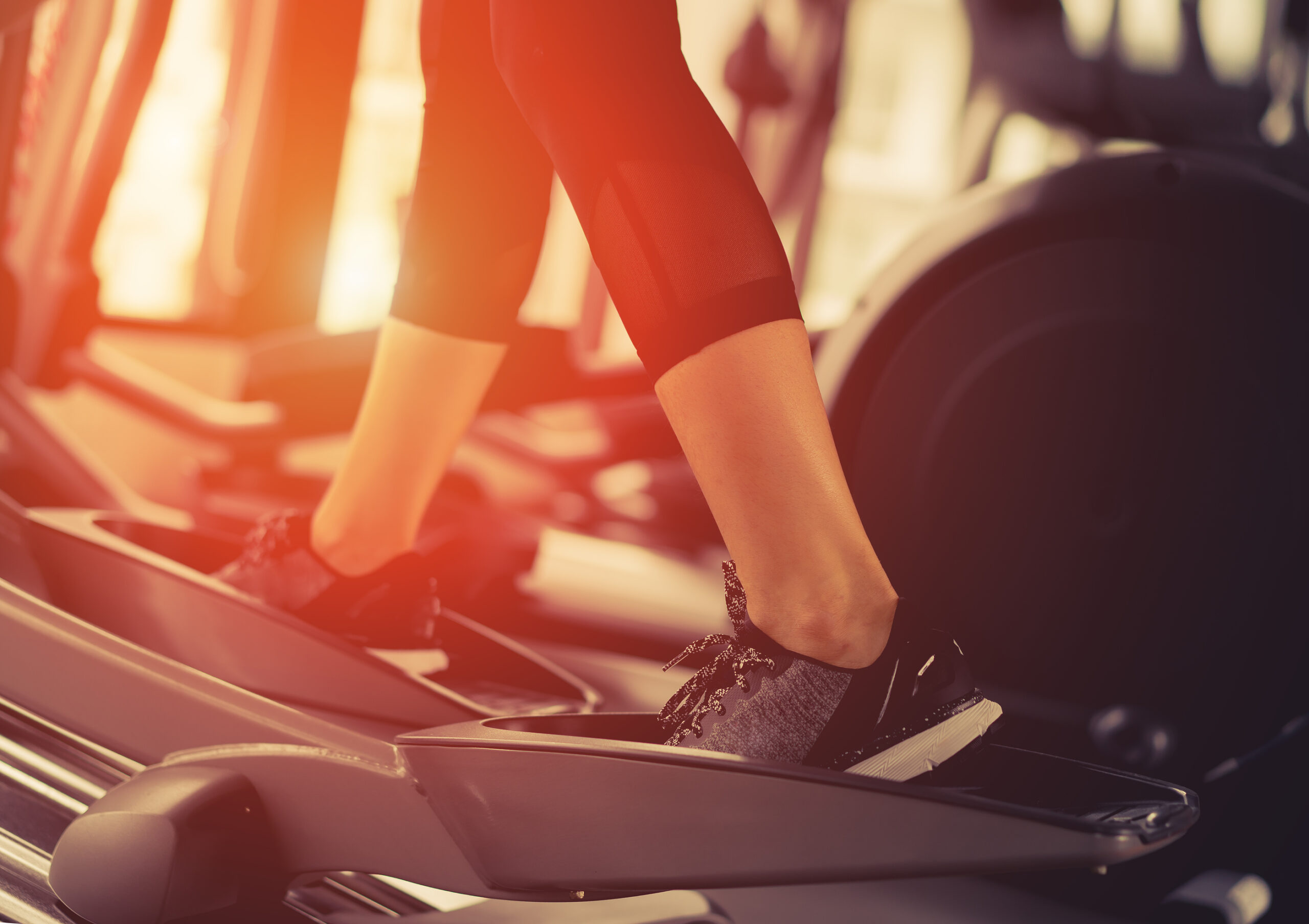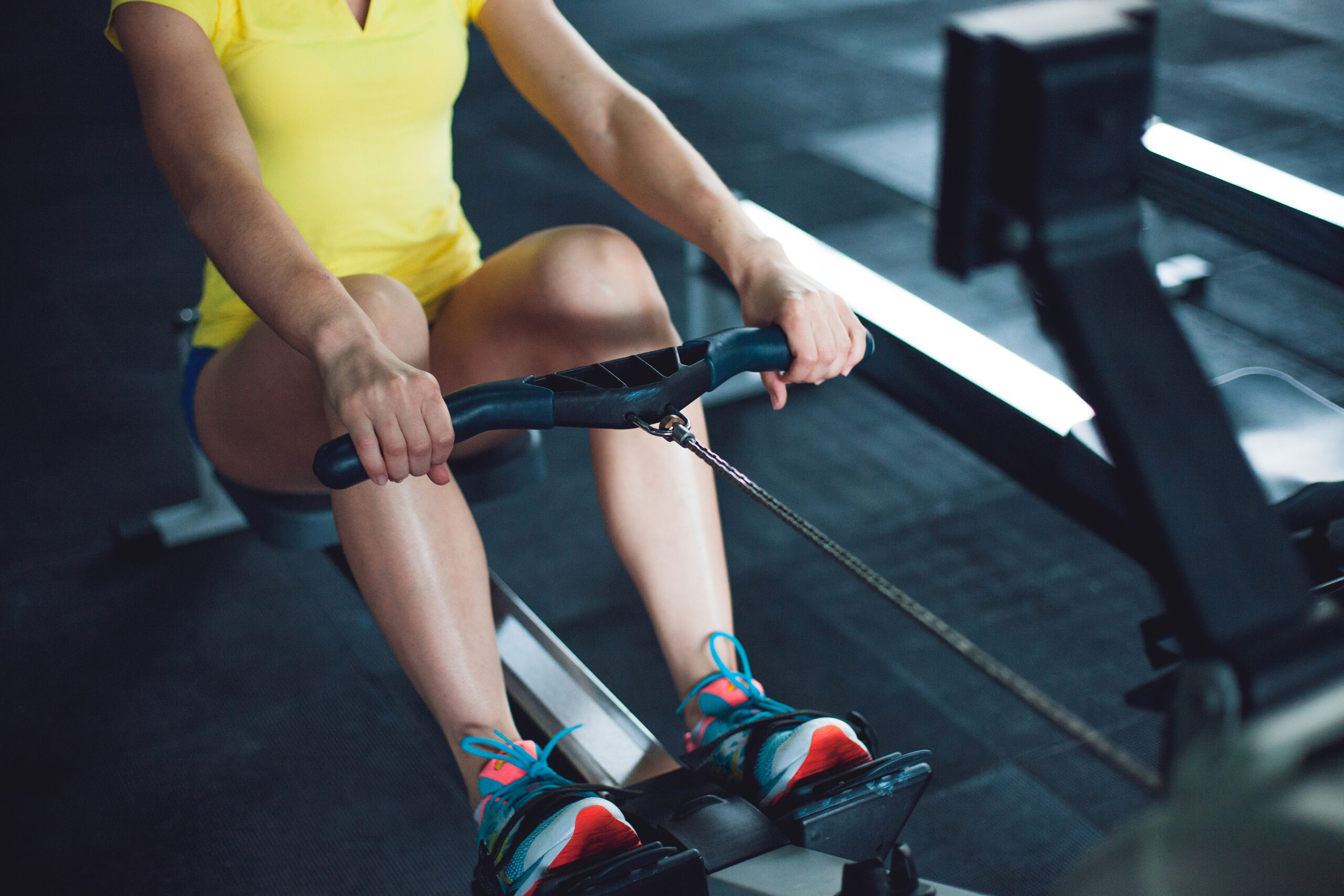Rebounding has become an increasingly popular exercise option for seniors looking to improve their fitness in a safe, low-impact way.
Using a mini-trampoline, or rebounder, seniors can enjoy cardiovascular benefits, enhanced balance, and muscle strengthening – all while being gentle on the joints.
But how do seniors and/or caregivers find the best option to meet their needs?
Well, if you found your way here you’re off to a good start.
In this guide, we’ll discuss the key features to look for when buying a rebounder for a senior, as well as go over some of the top models available.
We’ll also explain how these mighty little trampolines can help seniors stay active and provide a few additional tips to help you get the most from your workouts.
After reading, you’ll be more than ready to find the right rebounder.
| Size | Safety Bar Compatible? | Weight Limit | |
| Bellicon 44″ | 44″ | Yes | 440 lb |
| JumpSport 430 | 44″ | Yes | 275 lb |
| JumpSport 230 | 39″ | Yes | 250 lb |
| ACON Fit 44″ | 44″ | Included | 300 lb |
| Cellerciser | 40″ | Included | 400 lb |
| BCAN 48″ | 48″ | Included | 550 lb |
Why Rebounding is Great for Seniors
Before we get to the good stuff, let’s highlight why rebounding is such a fantastic exercise for older adults in the first place:
- Low-Impact Exercise: The trampoline surface absorbs much of the impact, protecting the knees, hips, and back from the stress of high-impact movements.
- Improves Balance and Coordination: Rebounding engages a lot of muscles at the same time, as well as stimulating proprioceptors, all of which can help seniors enhance their balance, stability, and coordination (which are key factors in reducing fall risk).
- Cardiovascular Health: Regular use of a rebounder can increase heart rate and circulation, improving cardiovascular fitness.
- Supports Joint Health: For seniors with arthritis or joint pain, rebounding is an ideal way to stay active without putting extra strain on sensitive joints.
- Boosts Mood: Like any form of exercise, rebounding releases endorphins, which improve mood and reduce stress.
Top 6 Rebounders for Seniors [2025]
Now that you know what to look for, here are six of the best rebounders for seniors, offering a combination of safety, durability, and comfort.
1. Bellicon 44″ Rebounder
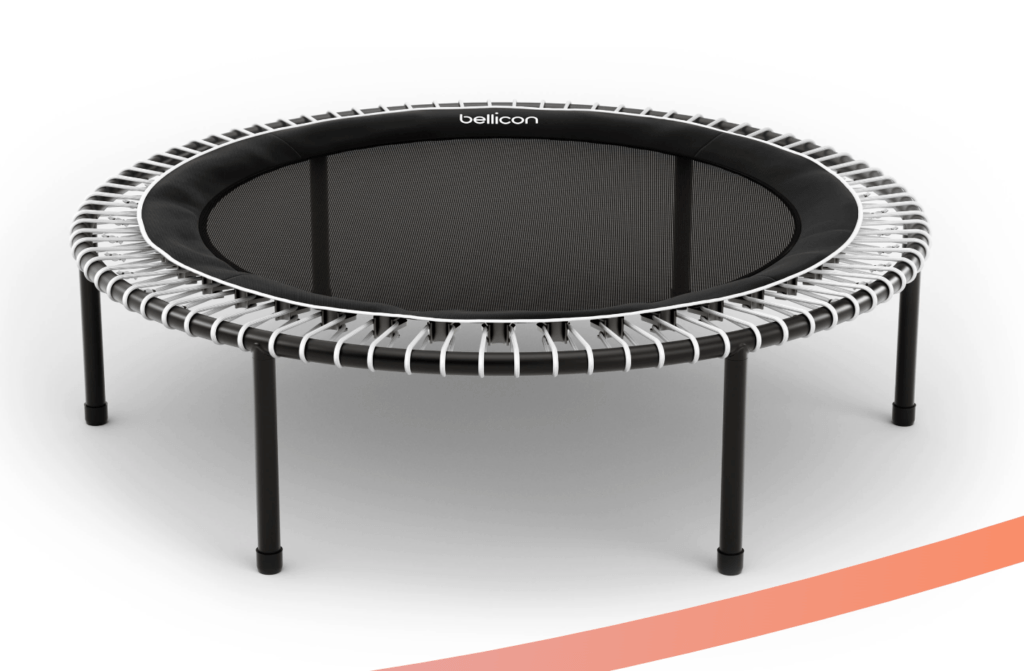
Key Features:
- 44″ diameter
- Quiet, bungee-based bounce
- Up to 440 lb weight capacity
- Customizable
- Great warranty
If you appreciate quality and are looking for a mini-trampoline that’ll last for years, Bellicon’s 44″ could be the right choice for you.
At 44″ in diameter, this rebounder is medium-sized, allowing it to accommodate seniors of various heights, while not taking up too much floor space.
And the solid-steel frame and stable screw-on legs make for a durable piece of equipment that’ll feel secure during workouts.
Bellicon uses bungees, so you can expect a comfortable bounce, and you get to choose the tightness of your bungees to meet your needs (based mostly on body weight, but you can also opt for firmer bungees if you’re looking for more challenging workouts).
Speaking of which, the Bellicon 44″ comes with a weight capacity of up to 440 lb, which is amazing for any rebounder (again, make sure you choose correct bungees to support your weight).
Also amazing is the warranty – Bellicon backs their rebounders with a lifetime frame, 3 year mat, and 2 year bungee guarantee.
There’s really not much to complain about here, but all this bouncy awesomeness doesn’t come cheap – with a starting price of around $700, this is one of the more expensive rebounders in its class.
And no, that price doesn’t include a stability bar (but one can be purchased separately).
Oh, Bellicon offers a lot of extra accessories to make your workouts more comfortable, like carrying cases, textured jumping socks, and more.
Overall, if you’re looking for a high-quality rebounder that’s entirely customizable, Bellicon is definitely worth considering.
#2 JumpSport 430 Fitness Trampoline
Key Features:
- 44″ diameter
- Bungee bounce system
- 275 lb weight capacity
- Bolt-on legs
- Great warranty
If you like the Bellicon rebounder mentioned above, but are looking for something a bit more affordable, JumpSport is a brand worth exploring.
They offer several models to choose from, but the 430 is one of their mid-range rebounders and it’s got a lot to offer for the cost.
At 44″, the 430 offers a spacious jumping surface and like the Bellicon above, it too uses bungee cords (36 to be exact).
The bolt-on arched legs offer a stable, no-slip grip, but they do take a little longer to assemble.
And with only a 275 lb weight limit, the 430 won’t be the best option for larger seniors, but it’ll still fit most users.
JumpSport also offers a lifetime frame and legs warranty, as well as a couple years for the bungees themselves.
At around $350, the 430 is a well-priced rebounder, but that price doesn’t include a stability bar, so you’d have to pay a little extra to have one.
Overall though, JumpSport’s a top of the line brand with some great rebounders to choose from.
#3 JumpSport 230 Fitness Trampoline
Key Features:
- 39″ diameter
- Bungee bounce system
- 250 lb weight capacity
- Softer feel
- Great warranty
Speaking of JumpSport, here’s another great model.
The 230 is a smaller, more affordable rebounder, making it a good choice for smaller seniors or folks with smaller workout areas.
The 230 comes with a 39″ diameter, so it doesn’t offer quite as much wiggle room during workouts, but it uses the same high-quality bungees found on their more expensive models.
This rebounder comes with a softer feel, making it a better choice for beginners and seniors who aren’t looking for aggressive workouts.
And with only a 250 lb weight limit, the 230 isn’t designed for larger folks.
But with a starting price around $200, the 230 is quite a bit more affordable than some of the other top rebounders out there.
Keep in mind though, this trampoline doesn’t come with a stability bar, so that would be an additional cost.
All things considered, JumpSport’s 230 would be a nice fit for smaller seniors or folks looking for a gentle bounce that won’t break the budget.
#4 ACON Fit 44″ with Handlebar
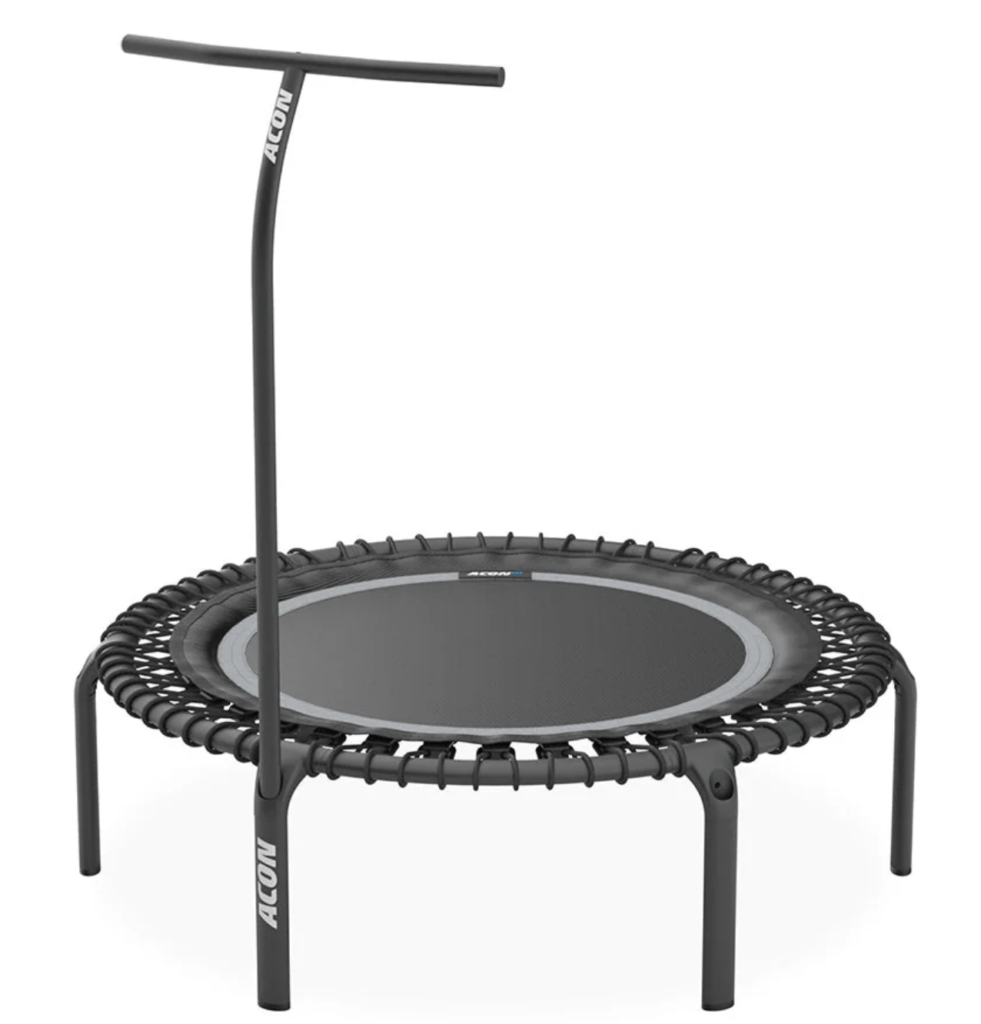
Key Features:
- 44″ diameter
- Bungee bounce system
- 300 lb weight capacity
- Safety bar included
Ok, time to move on from JumpSport and discuss another great rebounder brand, ACON.
ACON offers several rebounders to choose from, varying in size and features, but it’s their Fit 44″ model that I could see working for a lot of seniors.
For starters, the 44″ size is a nice mix between being spacious enough for comfortable movement, but still not taking up too much floor space.
I like that the Fit 44″ uses quiet bungees and comes with sturdy, non-slip legs, but what really sets the ACON apart from most is the fact that it does come with an included safety bar.
That’s right, the safety bar is included with this rebounder.
Which is impressive, considering this rebounder usually costs under $400.
Now ACON’s warranty isn’t quite as generous as JumpSports, but their guarantee is impressive for this price range: 10 year frame, 2 year mat, 1 year bungees.
The only real downside I see here is that at 35 lb (with the safety bar installed), the Fit 44″ isn’t the lightest rebounder around.
So, it could be a little more challenging for seniors or caregivers to move around – but that extra weight will make for a more stable feel.
If you’re looking for a well-priced rebounder that already comes with the safety bar, ACON’s Fit 44″ could be a great fit.
5. Cellerciser Rebounder

Key Features:
- 40″ diameter
- Patented spring system for smooth bouncing
- 400 lb weight capacity
- Folding frame for easy storage
- Stability bar included
The Cellerciser Rebounder is a premium option for seniors who want a top-of-the-line mini-trampoline.
And unlike all the other rebounders mentioned above, this rebounder uses springs, which the folks at Cellerciser would argue is superior.
Technically, it features a triple-tiered spring system that provides a soft, controlled bounce, ideal for joint protection.
It’s debatable whether or bungees or springs are superior (and it’s likely more an issue of preference than anything else), but what’s not up for debate is that the Cellerciser’s springs are built to last.
This is evident in the fact that these springs are backed with a 5 year warranty – and the frame, feet, and pins are backed with a lifetime warranty.
The heavy-duty frame and stainless steel springs ensure durability and stability, but it also has a weight capacity of 300 lbs, which is great for a folding rebounder.
Yup, that’s right – the Cellerciser can fold in half for easy storage and transportation.
The optional stabilizing bar makes it a great option for seniors and the included travel case makes moving it more convenient.
The biggest downside is the cost – at around $600, this isn’t a cheap rebounder (but that price does include the stabilizing bar).
But again, you know what they say about getting what you pay for.
#6 BCAN 48″ Mini Trampoline
Key Features:
- 48″ diameter
- Bungee bounce system
- 550 lb weight capacity
- Folding frame
- Adjustable stability bar included
Rounding out my list here is an affordable rebounder with some great features for the price.
This BCAN rebounder has become one of the most popular mini-trampolines on Amazon, and given the competition, that’s saying something.
At 48″, this is a full-size rebounder, allowing for plenty of space for mini-squats, lateral movements, and any other rebounder exercises you’d want to try.
This model also uses a bungee system and with a robust steel frame, it comes with a really high weight capacity (550 lb).
I also like that it comes with a large safety rail that’s adjustable to 4 different heights, allowing it to accommodate seniors of all heights.
The BCAN can also fold away for easy storage, which is always nice.
With an asking price under $200, there’s not much to complain about here, but the one glaring con here is the lack of a warranty.
BCAN only covers this rebounder with a 1 year warranty, which is short, but for this price range it’s the norm.
But if you’re looking for an affordable rebounder that comes highly-rated, BCAN is a good brand to try.
What to Look for in A Senior-Friendly Rebounder
When selecting a rebounder for a senior, it’s important to consider specific features that prioritize safety, as well as comfort and ease of use.
Here are the top priorities you’ll likely want to consider when comparing options:
Stability Bar
One of the most important features for seniors is a rebounder with a stability bar.
Also known as a safety rail or handrail, the stability bar gives seniors a place to hold on while exercising.
This can provide a great deal of added stability, making a rebounder safe for seniors who otherwise wouldn’t be able to use them.
Stability bars are particularly helpful for beginners or seniors with mobility challenges, but they can come in handy for seniors of all fitness levels too (it’s nice having one to hold onto when you get fatigued).
It’s worth knowing that not all rebounders come with a stability bar – some do, some don’t.
Some rebounders also may not come with one included, but are compatible with one if purchased separately.
Comfy Bounce
The goal should be to find a rebounder with a soft, controlled bounce, but that can obviously be a little hard without taking one for a test-bounce first.
However, models with bungee cords instead of traditional metal springs tend to offer a gentler bounce, making them ideal for seniors who need extra joint protection.
Some rebounders actually come with the ability to adjust the tension as well, which could be handy in homes with multiple users.
Durable & Sturdy Frame
A strong, durable frame is essential to ensure stability and safety during workouts.
High-quality rebounders should have non-slip feet and a frame made from sturdy materials like steel to prevent tipping or wobbling.
A quality rebounder should also have a protective covering over the springs/bungees for added protection during workouts.
Size
Rebounders come in various shapes and sizes, so you certainly have plenty of options to choose from to meet your space needs.
That said, most rebounders are round and come with diameters ranging between 36 – 48″.
Most are also about 12″ off the ground, so you need to make sure you’re able to step this high to safely access the mini-trampoline for workouts.
The optimal size for you largely depends on personal preference and how much floorspace you have to work with, but taller and more mobile seniors might prefer a larger option for added comfort.
Many seniors may also want to store their rebounder when not in use.
In these cases, a foldable or easily portable rebounder might make more sense.
Some models are lightweight, making them easier to move around the house than others, so you may want to consider assembled weight when comparing options.
Oh, some rebounders come with fold-away legs and even frames that can fold in half for storage (although a folding frame would likely take away from the overall stability).
Weight Capacity
Regardless of what other features you’re looking for, it’s a must to check the weight capacities before buying anything.
First and foremost, you have to make sure the rebounder can safely support the senior – safety always comes first.
Most rebounders have weight capacities ranging from 200 to 400 lbs, so there are options out there for seniors of all sizes.
Make sure you choose one that comfortably accommodates the user’s weight with room to spare.
Warranty
It’s a good idea to check out the warranty for any prospective rebounder too because this can give you a good idea as to its overall quality.
This rule isn’t written in stone anywhere, but generally speaking, nicer rebounders come with longer warranties.
But warranty coverage will vary greatly.
You can expect anywhere from a 1-year guarantee to lifetime frame and multiple year bouncing surface guarantees.
When in doubt, go with the longer warranty.
Assembly
This factor may not make or break a decision, but it’s still worth thinking about before deciding on a rebounder.
Some models are easier to put together than others, so if you’re not the handiest person around, you may want to look for a rebounder with a simple assembly process.
For example, some come mostly put together already where you really only have to screw the legs on.
How to Use a Rebounder Safely as a Senior
Rebounders are generally a safe and effective way for seniors to stay active, but it’s important to follow some basic guidelines to avoid injury:
- Use a Stability Bar: If balance is a concern, always use a rebounder with a stability bar for added support.
- Start Slow: Begin with short sessions (5–10 minutes) and gradually build up as you become more comfortable.
- Wear Supportive Shoes: Athletic shoes with good grip and support can prevent slipping and reduce foot discomfort.
- Create a Safe Space: Ensure there’s plenty of space around the rebounder, free of obstacles that could cause tripping.
- Warm Up and Cool Down: Start each session with light bouncing to warm up and end with stretching to cool down.
Final Thoughts
Well, there ya have it.
Rebounding’s an excellent form of low-impact exercise that can help seniors improve balance, cardiovascular health, and overall fitness.
And by choosing the right rebounder, seniors can enjoy a safe and effective workout that supports healthy aging.
Speaking of which, when it comes to choosing a rebounder, make sure you keep the important stuff in mind when comparing options:
- Size
- Safety bar compatible?
- Warranty
- Cost
Seniors looking for a softer, more gentle bounce may also want to consider going with a bungee cord system vs a spring system, but springs do tend to last a bit longer (although replacing bungees is pretty easy).
Anyway, I hope you found this guide helpful.
If you’re ready to get started with rebounding, the rebounders mentioned above are some of the best options available, but if you know of any that deserve a spot on this list, please let me know.
Feel free to leave comments and/or questions below and I’ll get back to you shortly.
In the meantime, happy bouncing!
